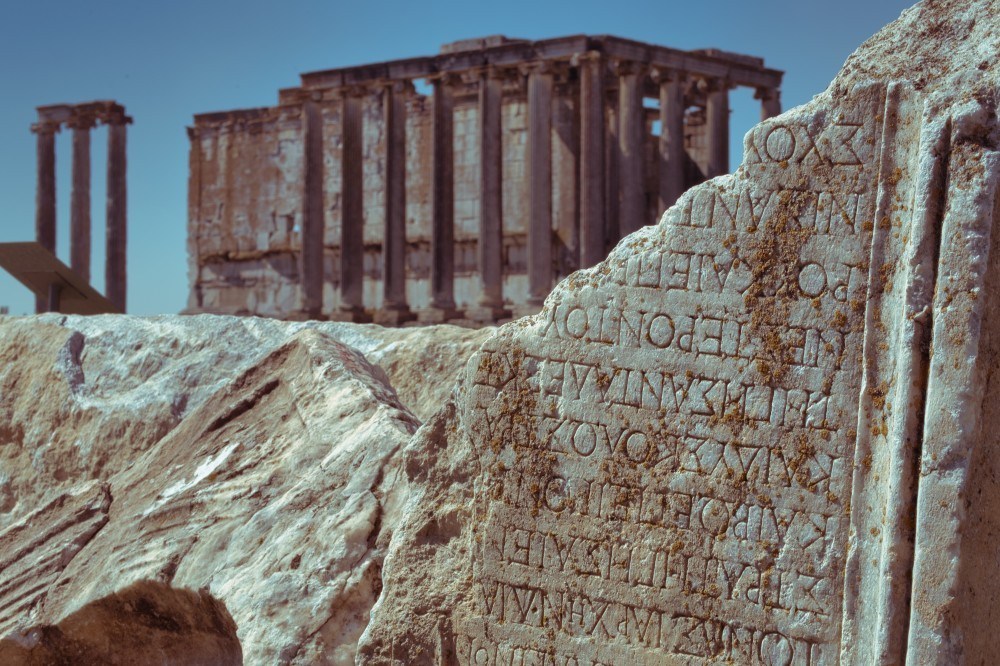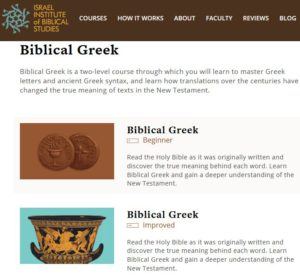
This article takes the reader through the evolution of Greek as a language over time. The history of Ancient Greek, English translation approaches to the Bible, and the best courses online in Biblical Greek are all covered in what follows.
The reader’s appetite is whetted on how to learn the language with the help of a renowned institution. These courses help to facilitate interpretation of the Bible and overcome all limitations of translation. Finally, the reader is called to action with the most equipping of incentives.
Ancient Greek
Ancient Greek was the form of Greek spoken in ancient Greece between the 9th century and 6th century BCE. Ancient Greek was the language of historians, scriptwriters, and academics of Athens in the fifth century. Several educational systems of the occidental world have subsequently studied it since the Renaissance. As a result, ancient Greek constitutes a significant portion of the origin of words found in the English language vocabulary.
Ancient Greek is a language with several forms. Hence, it has many dialects with several subdivisions. However, the main ones are Attic, Ionic, Arcadocypriot, Aeolic, and Doric. Some of these dialects are in standard literary systems, while others are in writings alone. Homer, the legendary author, had ancient Greek as his language with a dialect named after him, the Homeric Greek. This form of Greek was used in his widely known poems: Iliad and Odyssey. Thereafter, several authors used it.
Ancient Greek has long vowels and short vowels, as well as diphthongs. It has not only single but also double consonants, using voiced and voiceless or aspirated stops and even the so-called pitch-accent. The use of words in ancient Greek is highly dependent on the form being used.
Its nouns are in five cases (nominative, genitive, dative, accusative, and vocative). The verbs have four moods: indicative, imperative, subjunctive, and optative. Just like the English Language, they also have various tenses.

The Septuagint and Koine Greek
In ancient Greek, the Septuagint is translated from the Latin phrase Septuaginta interpretum which means ‘Translation of the Seventy’. This is so because it was recorded that the Torah (the five books of Moses) was translated by 70-72 Jewish scholars with 6 each from the twelve tribes of Israel at the request of the Pharaoh of the Ptolemaic Egypt between 285 and 247 BCE. It is the earliest existing Koine Greek translation of the Hebrew Scriptures.
[If you are interested in knowing how to learn Biblical Hebrew, read here my article on this topic.]
The biblical Old Testament had the Septuagint as its Koine Greek translation. It is known also as the Greek Old Testament. Parts of the Septuagint contain idioms and phrases with roots in Semitic languages while other parts fully show the Greek influence.
The Koine Greek is also known as Hellenistic or Biblical Greek, Common Attic, and Alexandrian dialect. It developed because of the spread of Greek, which was the lingua franca in most parts of the Mediterranean zone, and the Middle East Region. This was after Alexander the Great conquered virtually everywhere he wanted by fourth century BC.
Koine Greek developed into Medieval Greek and eventually to Modern Greek. It is the language in which the New Testament has been written, therefore, it is widely known as the biblical Greek. Koine was derived from the Greek term, koinè diálektos that means common dialect. It introduced a number of phonological changes to the ancient Greek, making it more in tune with Modern Greek phonology. The most important changes are the loss of vowel length distinction, replacement of the pitch accent system by the stress accent system, and the conversion of several diphthongs to monophthongs.
Language of the New Testament
Koine Greek is the language in which the New Testament was written initially. It was the common language of eastern Mediterranean from 335-323 BCE until 600 CE. Koine Greek developed because of two main reasons: more comprehensive political structures and the spread of ancient Greek culture and civilization during the reign of Alexander the Great. Even after Rome conquered Grece, conquering also Egypt in 31 BC, Koine Greek remained the principal language throughout the eastern region of the Roman Empire.
Many people believe that the Greek version of the New Testament is its original form. However, other specialists are of the opinion that it renders an Aramaic text. Jews abroad, such as Apostle Paul and Luke, wrote many New Testament texts and the texts were largely written to Christians in Greek-speaking cities. This strengthens the credibility of Greek as the original language in which the New Testament was written.
Some fragments of the New Testament correctly record Jesus’ words. During the first century, the languages that people spoke in Galilee or Judea, the provinces where Jesus grew up, were predominantly Semitic Aramaic, Greek as well as Hebrew. Many scholars argue that natives in Galilee and Judea spoke Aramaic, which explains why Jesus could speak Aramaic and the possibility of speaking Hebrew and Greek as well.
[Do you want to learn Aramaic, the language of Jesus? Read here my article on this topic.]
Bible Translations into English

Many persons, researchers and working groups have tried to translate the Bible at various times. Today, there are over 450 translations of the Bible in the English language, including the popular King James Version, the New International Version, The Living Bible and a host of others.
Initially, some unique monks and biblical scholars translated the Bible into the English language in parts, from the Vulgate (a fourth-century Latin translation of the Bible) in the 7th century until John Wycliffe’s work where he translated the entire Bible. The three eras of the English translation of the Bible are:
- The Old English era
- The Middle English era
- The Early Modern and Modern English era.
At the time the Bible was translated into Old English, most books of the Bible had not been compiled together. Hence, its allegoric rendering, that is, it was not taken as literal and was assumed to have spiritual and symbolic meanings.
In 639-709 CE, Adhelm translated the book of Psalms and other major parts of the Bible. Aldred made the translation of the Gospels in the 10th and 11th centuries. Abbot Aelfric made significant contributions to the Old Testament translation.
The Middle English translations include the Ormulum, which places more emphasis on personal comments and pays little attention to the biblical text. Many translators employed this approach of translation also. John Wycliffe was credited with the translation of the Wycliffe’s Bible.
The early modern translations were based on Latin translations. This period is between 1500 and 1800. This era began with the inaugural whole edition of the New Testament in 1526 by William Tyndale. The first translation of the whole Bible at the time was the great Bible of 1535 by Miles Coverdale who used Tyndale’s work together with his.
Other published versions were the Geneva Bible and the Bishop’s Bible. The first Roman catholic Bible was the Douay-Rheims Bible, which had seven Deuteronomic books in addition to all others. Unlike previous translations, Modern English translations were based on the original texts in Hebrew and Ancient Greek. English translation was approached in different ways by the translators.
In recent times, there have been individual translations such as the Message, the Bible in Basic English, the Living Bible and many others.
How to Translate Ancient Greek
For Ancient Greek, English translation should sound exactly the way the text does in its original language. In translating Ancient Greek, an understanding of prepositions, conjunctions, their meaning, and cases that should follow them is needed. So also is the knowledge of pronouns and how they should be used.
One should recognize structures with infinitives and participles. In Greek, several words in different parts of speech are formed from a root word; hence it is important to learn and understand words from their root; consequently, the use of prefixes and suffixes. A translation would be a lot easier with a proper understanding of all these.
In translating, it is important not to immediately jump on the dictionary for the sake of context. It is much better to read the title or search through a given text for names of ancient or legendary figures and places and try to recollect previous information that has been retained about them. Next, read the text a few more times to identify major sentences and concepts.
Then, try to identify each sentence and clause separately while highlighting syntactical structures. This helps to translate each part as a single unit. Translation should then be attempted without the help of a dictionary, by writing out the first draft out offhand. Introduce the dictionary to fix all the errors found in the draft. With the help of a dictionary, the second draft can now be written. Crosscheck for incongruences that should be corrected. Then, the final draft can now be written.
The Right Place to Learn Ancient Greek
 The Israel Institute of Biblical Studies is an institution that aims to create the possibility that numerous people around the world have access to the original meaning of the Bible. This is by providing biblical study and a platform for language courses students to connect with teachers to learn the original languages in which the Bible was written.
The Israel Institute of Biblical Studies is an institution that aims to create the possibility that numerous people around the world have access to the original meaning of the Bible. This is by providing biblical study and a platform for language courses students to connect with teachers to learn the original languages in which the Bible was written.
This ensures that people interpret holy texts themselves for an adequate understanding. The Institute works in partnership with one of the most prestigious academic entities in the world: the Hebrew University of Jerusalem. The partnership has yielded excellent results.
The Institute maintains superiority; hence, it offers students the best teachers, a strong and supportive community as well as advanced technology. This enables students to dictate the beat and rhythm of their own learning. The Institute prides in having exceptional experts in biblical languages and history. It offers a variety of fully accredited courses in Hebrew, Greek, Aramaic, and Yiddish for students to learn.
The Biblical Greek Course
This course is divided into two levels:
- Beginner level
- Improved level
Overall, students learn the Greek letters, ancient Greek syntax, and the effect of centuries of translations on the original New Testament texts.
Both courses are accredited by the Hebrew University of Jerusalem. 24/7 online forums, recorded lessons, extra practice sessions, and technical support for students all facilitate learning.
Beginner Level
 In this course, students will read the New Testament scriptures and translate them with the aid of passionate teachers. To achieve this, students would dedicate two hours every week for 9 months.
In this course, students will read the New Testament scriptures and translate them with the aid of passionate teachers. To achieve this, students would dedicate two hours every week for 9 months.
The syllabus has 30 units. Already in the first unit, students are reminded of the importance of Greek as a sacred language. They then learn the Greek alphabets in the next few units. By unit 4, they recite the Lord’s Prayer and learn new vocabulary. Unit 5 teaches the basics of Greek grammar, sentence structures, nouns, parts of speech, etc. The next two units deal with nouns and adjectives in details, respectively. Unit 8 discusses the popular depiction of Jesus as the good shepherd and adds new vocabulary. The next four units effectively explain declension of nouns and pronouns.
Units 13 to 15 introduce Greek verbs, and their tenses, moods, voices. Unit 16 revises everything that has been learned. Demonstratives, dependent and independent clauses, third declension of nouns, imperfect tenses, cover the next eight units of the syllabus. Units 25 and 26 deal with future tenses. Unit 27 is all about prepositions. The final three units revise and review all the basics.
Improved Level
This course follows the same path as course A. However, it includes Paul’s epistles, Jewish and Christian arts throughout history, and it presents the Old and New Testaments from a unitary point of view.
Its syllabus contains 30 classes. It revises everything learned in the previous course in its first six units. Unit 7 introduces the syntax of the infinitive. The following unit explains the exciting events surrounding the resurrection and ascension of Jesus Christ. The next four units explain participles in their various forms.
Unit 14 presents a new mood, the subjunctive, and this continues in the following unit. Perfect tenses, passive voices, imperative moods, and the entire essentials to a perfect Greek understanding are in the subsequent units. Subsequent units discuss and revise various important verbs. Accent marks are definitely not left out of the picture in units 26 and 27. Students enjoy texts from the book of Zechariah in units 28 and 29. The syllabus concludes with a reading of Psalm 96.

Did You Know?
- Over 12% of English words were derived from the Greek language
- Greek words can be expressed in three genders: masculine, feminine, and neutral.
- Vowels were first used by the Greek alphabet
- Ancient Greek was initially written from right to left, just like Modern Hebrew.
- Greek is one of the oldest recorded languages that is still living
- There are approximately 13 million Greek speakers worldwide
Ancient Greek Is Good for You!
Greek, as research shows, is very interesting. With its rich history and culture, it can be a great hobby, interest, and even skill to add to one’s repertoire. Understanding this language will definitely make a difference in our world today. Exploring Ancient Greek, English translation scripts, and their interrelationships definitely make Bible study more fun. In addition, Christians can build on their convictions with help from the discussed courses.